08/07/19
K-State Current - August 7, 2019
K-State Current is a weekly news update for the Kansas Board of Regents to apprise the Regents on a few of the many successes and achievements made by K-State faculty, staff and students.

K-State News
Save the dates: Kansas State University schedules two Landon Lectures for fall 2019
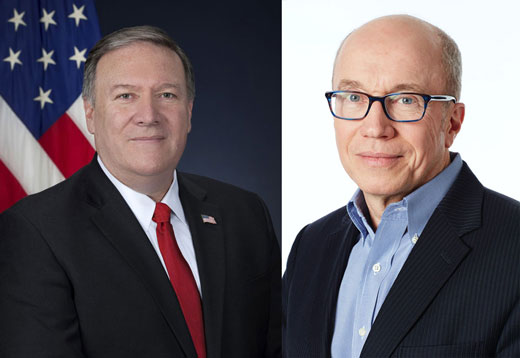 The fall 2019 Landon Lectures at Kansas State University will include U.S. Secretary of State Michael R. Pompeo on Friday, Sept. 6, and Fortune CEO Alan Murray on Friday, Sept. 27.
The fall 2019 Landon Lectures at Kansas State University will include U.S. Secretary of State Michael R. Pompeo on Friday, Sept. 6, and Fortune CEO Alan Murray on Friday, Sept. 27.
Kansas State University's Landon Lecture Series will kick off the 2019-2020 academic year with two lectures scheduled for the fall semester.
U.S. Secretary of State Michael R. Pompeo is scheduled to speak on Friday, Sept. 6, while Fortune CEO Alan Murray will speak on Friday, Sept. 27.
Both lectures will be in McCain Auditorium beginning at 10:30 am on their respective dates.
"This semester, we are honored to bring two prominent leaders with dynamic careers and formidable experiences to share thought-provoking messages on stage in the heart of America," said Linda Cook, chair of the Landon Lecture Series and the university's chief of staff and director of community relations. "Each will bring unique perspectives on diverse topics that impact all of us and the world around us."
K-State's Landon Lectures are free and open to the public. The lecture series, one of the most prestigious offered at a U.S. college or university, offers opportunities for students, faculty, staff and the public to hear directly from today's global leaders.
• Michael R. Pompeo, scheduled to speak on Sept. 6, is a former three-term U.S. congressman from Kansas' 4th District who ran two successful businesses in Kansas, became director of the Central Intelligence Agency and then Secretary of State under President Donald J. Trump.
• Alan Murray, scheduled to speak on Sept. 27, served as president of the Pew Research Center and chief content officer of Time Inc. before being named CEO of Fortune, overseeing the media company's global operations in print, digital and live events.
Additional information on the speakers and their topics will be available in the weeks ahead. Please visit the Landon Lecture Series website for more information on these lectures and future lectures to be scheduled in 2020.
K-State Faculty Highlights
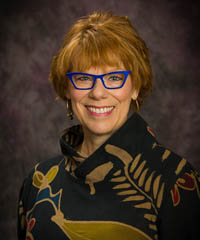 Marla Day, historic costume and textile museum curator, has been named a professional reviewer for the Hometown Treasures program.
Marla Day, historic costume and textile museum curator, has been named a professional reviewer for the Hometown Treasures program.
The Smithsonian's National Museum of African American History and Culture hosts the Hometown Treasures program. It looks to stimulate preservation activity nationwide, preserving objects of historical and cultural significance, identifying potential collections for the museum, and developing collaborations among cultural institutions and communities across the country.
Day will serve as a professional reviewer of textile items during the Save our African American Treasures event in Denver, Colorado, alongside Nancy Love, textile conservator in private practice, and Renee S. Anderson with the Smithsonian Institution. The event allows community members to bring up to three items and meet with the reviewers for a 15-minute session. The reviewers will help place the object(s) in historical context and provide them with advice on how to care for the items displayed. The reviewers will not provide a monetary value to items but the event will provide a list of local appraisers and resources.
This is Day's sixth time participating as a reviewer for the program. She has traveled to Detroit, Dallas, Birmingham, New York City, Topeka and Houston where she reviewed a large number of quilts and crocheted pieces, a few dolls and clothing. One particular object that she was thrilled to evaluate for a participant was a Black Sox uniform, a professional baseball team from Baltimore than won the American Negro League championship in 1929.
"The goal of the Treasures program is to help people learn how to care for their family's heirlooms, document their family stories that relate to that object in order to inspire current and future generations to hold onto these objects," Day said. "We can help them see unique features about their heirlooms by carefully studying and noting the details. These fresh insights and observations help them to understand how difficult or challenging it was to create an item, or to see in the wear patterns and patches from use, maker's marks, or the unnoticed little details of how it was made or when.
"It is up to each generation to spark curiosity about one's ancestors and family heirlooms," Day said. "If we don't honor these objects by keeping them safe, document what stories they hold, and share these at family gatherings, the cultural heritage of that object will be lost."
Day has been involved with the Historic Costume and Textile Museum, housed in the apparel, textiles, and interior design department in the College of Health and Human Sciences, since 1998. She was named curator in 2004. The museum is a notable collection of traditional and artistic artifacts, with more than 15,000 pieces. The collection began in the 20th century and continues to be augmented by friends, faculty and Kansas State University alumni who have lived and traveled throughout the world. More information on the museum can be found on its website.
To learn more about Save our African American Treasures, visit the event website.
K-State researchers to track water movement in plant stems
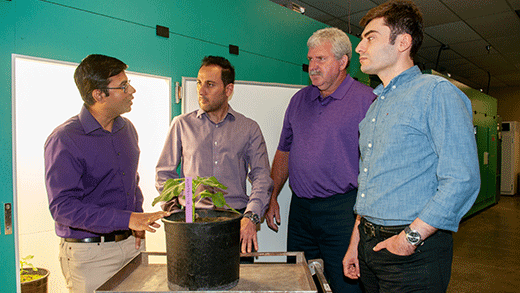 A team of K-State researchers is building a tool to measure sap flow -- or the movement of water -- in plant stems. Pictured, left to right, are Krishna Jagadish, Behzad Ghanbarian, Gerard Kluitenberg and Mohammad Shadmand.
A team of K-State researchers is building a tool to measure sap flow -- or the movement of water -- in plant stems. Pictured, left to right, are Krishna Jagadish, Behzad Ghanbarian, Gerard Kluitenberg and Mohammad Shadmand.
A team of Kansas State University researchers has been given the green light to explore how water moves through plant stems, an idea that could greatly improve the efficiency of its use in growing farm crops.
They have received $300,000 from the National Science Foundation for a two-year project that will build a tool to measure sap flow – or the movement of a liquid through plant stems.
“In this case, we are talking about water,” said Krishna Jagadish, associate professor of agronomy. “In a plant, roots take up water, which then needs to go to the leaves to participate in photosynthesis. The stems are the main road, or the highway. We are measuring the traffic of water on the highway.”
All plants, including farm crops, have different stages of growth, each potentially requiring different amounts of water. The K-State researchers hope to uncover how much water is moving through plant stems during various growth stages, and different times of the day, which should give a clearer picture of how much and when water needs to be provided through irrigation or other means.
“The core idea behind this project is that water matters, no matter if you live in Kansas, Texas, New York or anywhere else,” said K-State hydrogeologist Behzad Ghanbarian. “Given that the world’s population is increasing everywhere, we need to practice agriculture in a way that we make sure we will have water in the following decades for our kids and grandkids.”
Mohammad Shadmand, an assistant professor in electrical engineering, is working with the group to build a tool that utilizes nuclear magnetic resonance (NMR), a concept that comes from physics.
“It’s a non-invasive, physical tool,” Shadmand said. “We will use four magnets surrounding the plant stem to provide an external magnetic field around the stem, which allows us to detect how fast water is moving through it.”
The NMR tool never touches the plant, and would be capable of measuring sap flow in the plant at different times of the day. Past studies have tracked sap flow at a given point by physically cutting or inserting probes into the stem.
“When you go to the gym to work out, you breathe faster,” Ghanbarian said. “Breathing is a dynamic reaction in our body. That’s what happens to plants. They don’t continuously ‘breathe’ or use water at the same rate. In the morning, the amount of water being used, or the flow rate in the stem, would be different than in the afternoon or at night. It’s important for us to understand how much water is being used at different times.”
Jagadish noted that the project is funded through an NSF program known as EAGER (EArly-concept Grants for Exploratory Research). The program is intended to encourage high-risk and high-benefit ideas for transformative research. He said that sap flow has never been measured non-invasively in the United States using nuclear magnetic resonance.
“At this time we really don’t know how it will work,” Jagadish said, adding that the tool could be commercialized if the researchers’ work is successful. “This is a tool to guide us in the direction to help farmers. There may be intermediary people – engineers or modelers or others – who will actually use the tool. In time, we can possibly quantify the amount of water that we are currently allocating and determine if that is efficient or not.”
Gerard Kluitenberg, K-State professor of agronomy in soil and environmental physics, is testing the NMR tool in laboratory settings. The researchers will then conduct field tests with sunflowers, and eventually will include other farm crops.
“We really don’t know how much water plants require for any specific environment,” Jagadish said. “If you put too much, you are wasting water; if you do not irrigate enough, you lose yield. In the long term, this tool will help farmers optimize production practices, or increase crop per drop. To make that into reality, you need tools like this.”
K-State Student News
Master's in security studies ranks sixth in national Top 25 best list
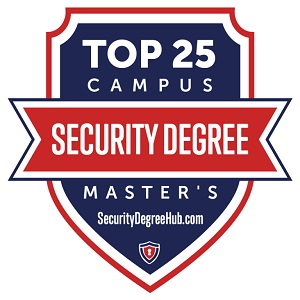 Kansas State University has been ranked sixth in the Top 25 Campus Master's in Security Studies Programs for 2019 by Security Degree Hub.
Kansas State University has been ranked sixth in the Top 25 Campus Master's in Security Studies Programs for 2019 by Security Degree Hub.
The ranking shows students that K-State's program is a leader in the field, and a career opportunity like no other. For security professionals who want to move into management and administration, a master's degree is key. Traditional on-campus programs like K-State's provide the mentorship, community, and experiential learning serious students need to do it right.
K-State named Top 10 school for bachelor's degree in media communication
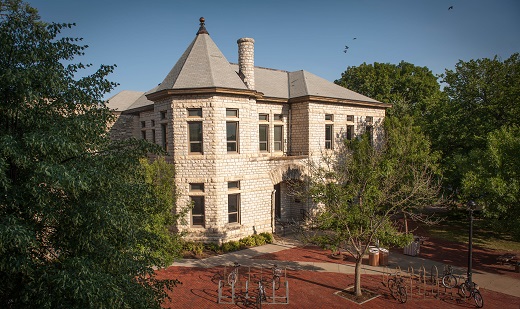 The A.Q. Miller School of Journalism and Mass Communications is among the best programs in America for receiving a degree in media communications, according to the Bachelor's Degree Center, a website dedicated to helping prospective students find programs best suited to their career interests in terms of their financial, educational and personal interests.
The A.Q. Miller School of Journalism and Mass Communications is among the best programs in America for receiving a degree in media communications, according to the Bachelor's Degree Center, a website dedicated to helping prospective students find programs best suited to their career interests in terms of their financial, educational and personal interests.
The center's site ranked the 25 best bachelor's programs for media communications degree programs in 2019, citing the basic selection criteria as programs that offer a focus "beyond the simpler days of radio, television and publishing." In that regard, the A.Q. Miller School ranks ninth, accompanied by such programs as North Carolina, Alabama, Georgia, Penn State and Iowa, and was the only media program among Big 12 schools to make the list. The center first chose its schools based on their status as nationally accredited programs, then data was collected on such factors as alumni salary information, graduation rates, job placement, student reviews and tuition costs.
The main benchmark cited by the center, however, was the A.Q. Miller School's recent curriculum overhaul, which was developed over three years beginning in 2015 and inaugurated last fall. The curriculum, which features concentrated study in Journalism or Strategic Communications — a sequence that encompasses advertising and public relations — was designed to give freshmen basic exposure to media writing and production skills from their first day of classes at K-State, allowing them to more quickly develop skills sets and learn professional standards. The center's selection team was impressed with the fact that the A.Q. Miller School "radically renovated its curriculum with an emphasis on cross-media communication … emphasizing experiential learning for production skills." Students are allowed to freely pick and choose skills building courses as they advance in the program, while honing their skills at award-winning campus media operations, including the Collegian, Manhappenin' and Update magazines, KSDB-FM 91.9 and KKSU-TV Channel 21. Each of those media outlets has companion web and social media platforms, and a multimedia news desk gathers information for distribution across those channels.
Students can earn a Bachelor of Arts or a Bachelor of Science. The program also has a master's program specializing in community journalism or health, risk and crisis communication, and has recently launched an online master's program in strategic communication. The school is also a partner in K-State's interdisciplinary doctoral program in leadership communication.
"We're thrilled to be on a list of such prominent names in media education," said Steve Smethers, the interim director of the A.Q. Miller School. "Our faculty worked hard to develop a curriculum that enhances basic skills and professional standards, while stressing modern trends in media technology, management and changing consumer tastes."
As examples, Smethers cited the A.Q. Miller School's status as one of five programs nationally to feature drone photography and video technology, the addition of courses in social media as a tool of both journalism and strategic communication message dissemination and new courses based on media analytics as tools of audience analysis and strategic campaign development.